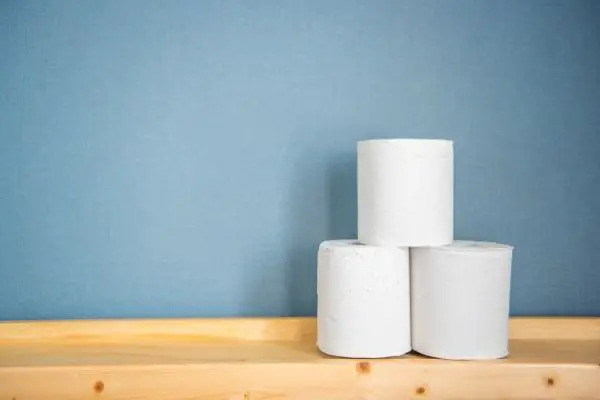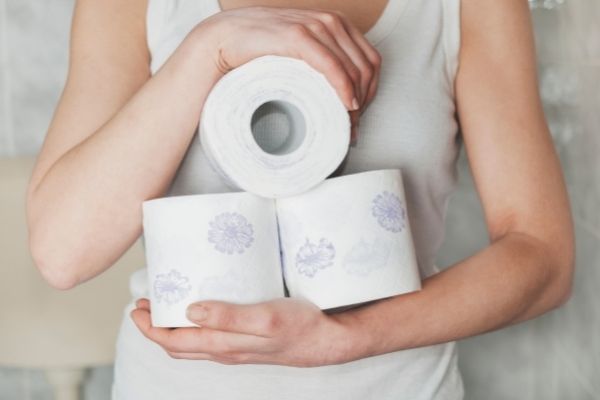Can Toilet Paper Get Moldy? | Bulk Buying Tips
Not many people think of product expiration dates and shelf life when they are gripped by the frenzy of panic buying.
Surely you’ve seen the news where consumers go on a buying spree during the pandemic-related lockdowns in the last two years?
One essential that many consumers hoarded was toilet paper.
Panic buying aside, toilet paper subscriptions are becoming increasingly popular, however, most companies only ship large amounts (48 rolls is the most common). That gets even trickier for single-person households or small families.
Unfortunately, many people are not aware that there are health aspects to storing large quantities of TP.
So, can you really stockpile toilet paper without risking the growth of molds?
Unless you are storing the toilet paper in extremely dry conditions, moisture will form on the surface. As a result, there can be a high chance of mold growth.
In short, yes – toilet paper can get moldy!
Let’s look into it in detail.
Why Does Toilet Paper Grow Mold?

To start with, let’s learn a few things about mold growth.
Molds or microscopic fungi are a part of our environment and an important part of the natural cycle of decay. In the outdoors, molds break up dead organic matter and convert it back to the soil. Mold is an important aspect of composting and bokashi.
You must have spotted mold growth on a dead tree while walking through a forest. In fact, nobody knows the exact number of mold varieties that exist. Some common varieties found indoors are Cladosporium, Aspergillus, and Alternaria.
Interestingly, the penicillin group of antibiotics was obtained from the Penicillium mold.
Despite all the benefits, you need to prevent the growth of molds in your home.
Molds reproduce through microscopic spores that travel through the air. In reality, there is hardly any place where mold spores cannot be found. Even a sterilized surgical chamber will have mold spores in it.
In most cases, the mold spores are harmless and can not grow without water. However, when they land on a wet surface and get the right temperature, they start growing.
You will find molds growing in areas around windows, pipes, or doors where there are water leaks. They can also grow on wooden surfaces, wallpaper, upholstery, carpet, insulation, or cardboard.
Even worse, they can start growing on clothes too.
Are mold and mildew the same?
There are many species of molds and one of them is mildew. Mildew has a flat profile and is lighter in color than mold. Most mildew is white or gray in the early growth stage and turns light brown in the later stages.
Now, most toilet paper is manufactured from recycled paper or wood chips. The paper has empty spaces within its fabric. The water molecules tend to fill up these spaces. Gradually the toilet paper will dissolve in water.
So if you are storing toilet paper in a space where it is damp or moist, there is a high chance that the paper will absorb water. As a result mold growth can happen over the surface.
Let’s not forget that exposure to mold spores is unavoidable. Quite simply, they are everywhere. So even if you keep the paper wrapped and sealed, you may not avoid mold exposure completely.
Why Should You Prevent Mold Growth In Your Home?
The most common risk associated with mold spores is they can act as allergens. And some people have high sensitivity to molds.
That means you can get a runny nose, rashes, red eyes, and fever from it. Some evidence has also linked molds with upper respiratory tract symptoms, shortness of breath, and cough.
For people with asthma and a compromised immune system, mold exposure can lead to severe asthma attacks and wheezes. This can also happen in some children. And if a child is genetically susceptible to asthma, exposure to mold can cause an asthma attack.
Beyond that, mold growth can also cause bronchial and fungal infections. Other symptoms like insomnia, headaches, nausea and sick-building syndrome are also possible.
In reality, research is still ongoing to evaluate the exact health effects of mold on humans.
This is the reason that you need to tackle the problem of mold the moment you identify it. On the other hand, mildew isn’t that much of a threat to your health.
Keep in mind, there are no clinically proven tests to ascertain mold exposure. Physicians can suggest a test for allergies in some cases.
Other than that, mold will also damage the surface that they grow on. You will be left with no other option but to discard the object suffering from mold damage.
In short, avoid mold growth on any object inside your home. And if the toilet paper roll looks moldy, discard it immediately.
How To Store Toilet Paper

Not a panic buyer but still need to store a few toilet paper rolls for use?
In most cases, toilet paper doesn’t come with a specific expiry date. But it can go bad if stored in the wrong manner.
Here are the best ways of storing toilet paper.
And if you don’t want to hoard or store toilet paper, think about shifting to a bidet to solve the problem once and for all. You can choose from electric or non-electric versions as per your convenience.
Frequently Asked Questions
How long does toilet paper take to decompose?
When kept in water, toilet paper will dissolve within a few minutes. If you are planning to store it, there may not be a fixed time period before it decomposes. When stored in the right manner, a toilet paper roll can easily last for many months. But do not use it if you spot mold growth on the surface.
What stops the growth of mold in toilet paper?
The best way to prevent mold is to keep the surfaces dry and allow proper ventilation to reduce moisture percentage in the rooms. So store the toilet paper rolls in a dry and dark place. Keep the original package sealed to prevent exposing the paper to the elements.
Why does my toilet paper have a date on it?
Generally, toilet paper does not come with an expiry date. So check if the manufacturer has actually mentioned the expiration date of the package. If so, use up the roll within the mentioned date.






